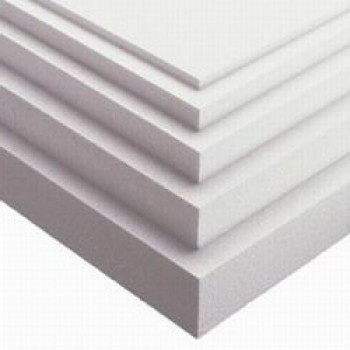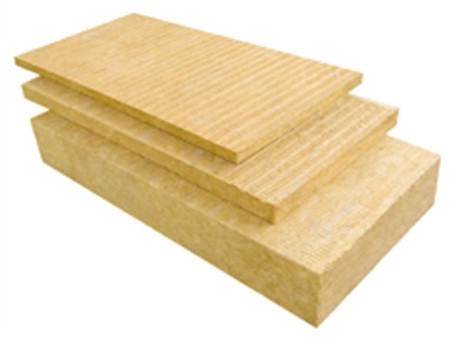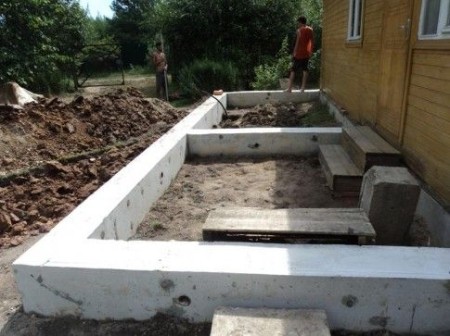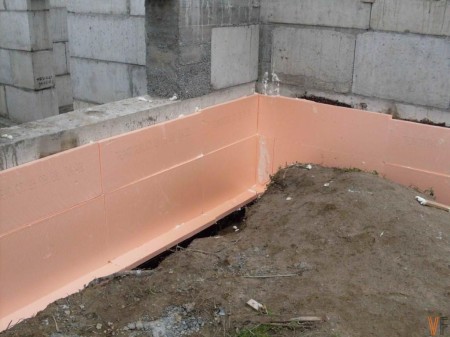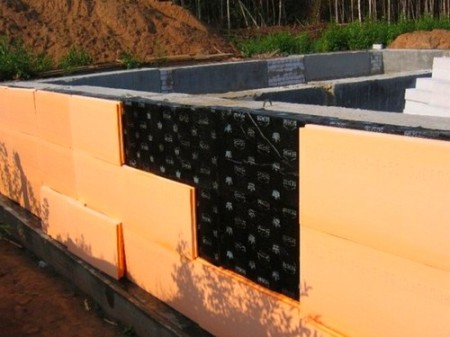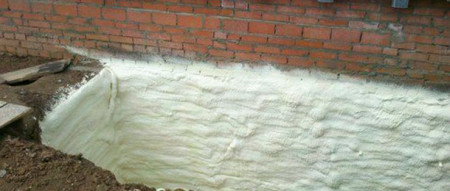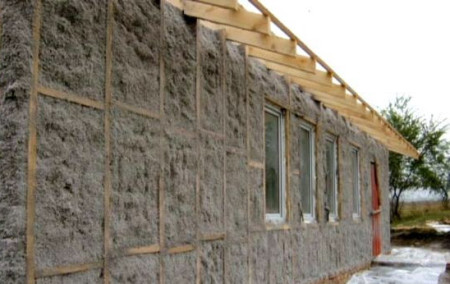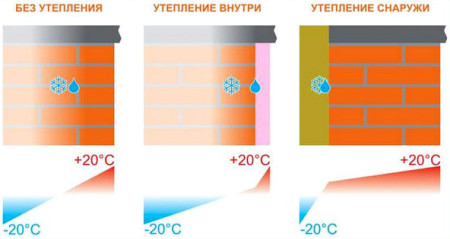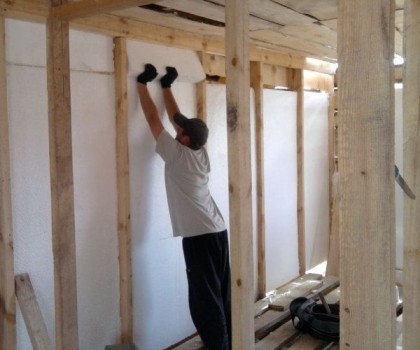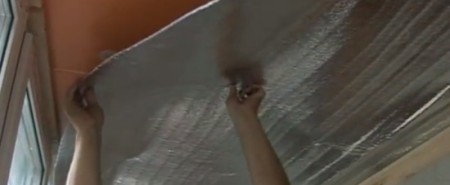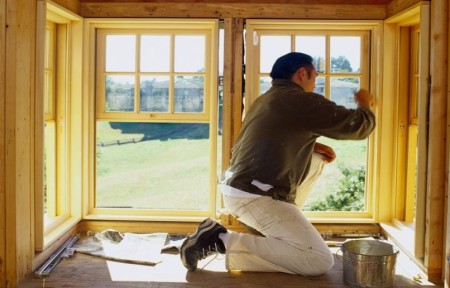Quite often there is a need to make a "heated" summer terrace a residential heated room. The reasons for each their own - someone wants to expand at the expense of the veranda living space, someone wants to arrange a kitchen on the veranda or put a shower, for lack of a suitable room. But in the overwhelming majority of cases, developers, especially owners of suburban areas, are limited to the warming of the verandah so that in winter it maintains a positive temperature due to the heat that comes from the house. This option, by the way, is most in demand, since it allows dacha owners to use the insulated veranda space as a storage for conservation and vegetables at a sufficiently low temperature.
In order to qualitatively warm the veranda, will have to work hard. The extension needs to be insulated in a comprehensive manner starting from the foundation. How to insulate the veranda, and what materials to use - read below.
Content
Than to warm? Choice of materials
The current market for building materials does not suffer from a deficit, and it will not be difficult to find a suitable heat insulator. The choice here is really huge - for every taste and for every wallet. Most developers prefer foam and mineral wool, as the most inexpensive and effective insulation.
But, using, for example, polystyrene, you need to take care of compliance with fire safety measures. The polystyrene does not burn very well, but melts at high temperatures, producing very toxic smoke. Therefore, if it is planned to make a kitchen on the veranda, it is best to reject the foam plastic.
As an additional insulation is well proven penofol.
Metallized coating of this material reflects well the ultraviolet radiation, keeping heat inside the room. Penofol consists of a foam polyethylene base and a layer of strong aluminum foil, which plays the role of a "reflector". This material can be used as an additional or basic insulation for the veranda. But still it is recommended to use penofol in combination with other, more effective thermal insulation materials, for example, mineral wool, polystyrene foam or polyurethane foam.
The latter proved to be quite good as an inexpensive and effective insulation of living quarters. It practically does not burn, and effectively saves heat even at very low temperatures.
External warming of the veranda. Foundation
The veranda is not only an additional room, which can be used for housing, recreation, or reception of guests. This is also a kind of buffer for the main premises, which in the cold season provides additional insulation of living rooms. Therefore, the warmer the veranda, the better the interior of the house is protected from cold.
Begin warming the veranda from the foundation - the foundation. It should be noted that this work needs to be done at the construction stage, but if it was neglected at the time, the situation can be completely corrected. The main thing is to be aware of where the most vulnerable places are located, and the main attention is given to them.
Most of the veranda is built on the same foundation as the main building - it can be concrete slabs, or a tape monolithic base. And although concrete is very strong material, it does not interfere with the cold free to penetrate into the interior, so that the foundation and the building can very thoroughly freeze. Heat loss through a non-insulated foundation can reach 25% or more. There are several ways to warm the foundation of the veranda with your own hands.
You can, for example, wake the voids between the segments of the construction with expanded clay or ordinary earth. True, this method can only be used when laying the foundation, or overhauling the room, as it will have to tear the whole floor to the ground. Landfilling, of course, is the cheapest method, but not very effective, since the soil does not retain heat sufficiently. It is much better to use expanded clay, which is a ball of foamed and burned clay - are beautiful, and, in addition, an eco-friendly thermal insulator. Very often, in order to save money and to achieve a good result, the expanded clay is mixed with the ground.
Most of the territory of Russia is dominated by cloddy soils, so the foundation built on such a foundation should not only be insulated, but also additionally strengthened. To this end, it is glued on the outside with sheets of expanded polystyrene.
This is a very reliable heat insulator that protects the foundation well, preventing it from contacting the ground during winter swelling. Styrofoam takes on a significant part of the load that results from the expansion of the soil, thus maintaining the integrity and strength of the foundation. This material is realized in large plates. The entire external surface of the basement and the plinth are glued to the plates.
The types of expanded polystyrene are ordinary foam and liquid polyurethane foam. These two materials have huge differences in both cost and performance characteristics. So, polystyrene - an inexpensive and beautiful insulation, if you use it inside the building. But it is practically unsuitable for warming the foundation, since under the pressure of the soil it will be strongly crumbled. In addition, the foam will gradually absorb moisture from the ground, and if you still decide to insulate the foundation with this material, take care of good waterproofing, otherwise in one season your thermal insulation layer will completely fail.
Liquid polyurethane foam is another matter. It does not pass at all and does not absorb water, perfectly keeps the load of the soil soils, it is frost-proof, and serves more than 50 years.
All the advantages of this heat insulator are somewhat pale against the backdrop of its impressive cost, but if you prefer high-quality materials and can afford it, then you should not save, especially if it's not a dacha, but a residential house.
To insulate the foundation with foam polystyrene, it is necessary to excavate the foundation to the very foundation. Sheets of the first row are laid on a pillow of gravel, before laying the thermal insulator, the foundation must be opened with a layer of bitumen mastic. After the bitumen dries, the insulation boards are glued with polyurethane adhesive, which is applied by dots or spread over the whole surface of the plate. Joints also need to be glued to prevent the occurrence of bridges of cold.
Spraying liquid polyurethane foam - one of the newest methods of insulation. But this method requires the availability of special equipment, which only specialists can work with. The method of spraying is good because it can quickly apply a layer of the 100th thermal insulation on the surface of any wall or foundation. Once the material hardens, it becomes very durable, but the cost of material and work, as we mentioned above, many times exceeds the cost of pasting conventional plates.
Internal insulation: how to insulate the floor on the veranda
When the basement is finished, you can work on the veranda floors. Insulation of the floor is a necessary condition, on the basis of which compliance depends, you will see black and green mold at the corners, or not.
If you plan to make a warm concrete floor on the veranda, then you need to think about everything at the stage of work with the rough floor. When installing a warm floor on a veranda, it is recommended to give preference to electric heating systems, which can be switched on as needed, thus saving on electricity.
But if you prefer traditional wooden floors, then you can warm them like this:
- Fill the space under the floor with small rubble.
- On rubble pour a small layer of clean sand, compact.
- Make a grid of reinforcement with a cross section of 10 mm (so that the concrete screed does not crack).
- Pour a layer of concrete about 5 centimeters thick.
- Once the concrete has dried, lay a layer of waterproofing. The cheapest option is to cover the concrete with a layer of roofing material.
- On the roofing material lay wooden logs, previously impregnated with antiseptics.
- Between the lags lay the heat insulator (mineral wool is recommended), you can use expanded polystyrene, the joints between the plates, you need to blow out the mounting foam. After the foam has solidified, its excess needs to be cut off. Next, you can lay a floor covering - a board or decking. The advantage of decking is that it is completely ready, processed material, which is not afraid of moisture or cold. Decking is great for covering floors on verandas and open terraces, however it costs much more than ordinary rough boards.
wall insulation outside
The total area of the walls is much larger than that of the ceiling or floor, therefore, and the heat loss through the walls is higher, and the walls of the veranda must be carefully insulated. To do this is quite simple, the only question that arises in inexperienced builders: how best to insulate the walls - outside or inside? There is no consensus on this, because each individual situation requires an individual solution, which depends on many factors. This is the climatic conditions, and the material from which the walls are built, the thickness of the walls, the type of insulation, etc. All this can be considered, pondered and made a decision, but if you want to achieve a good result, the walls of the veranda will have to be insulated from two sides.
Do not wait for the first frost, and feverishly warm the veranda. Take care of this need in advance, when the weather allows you to use any mortar and mortar. From the outside of the verandah wall, it is possible to insulate the foam with the help of fasteners "fungi". This type of fastener ensures a good fit of insulation sheets to the wall surface, evenly distributes the load, and allows air to circulate. Before the insulation, the wall is recommended to soak with the means of fungus and mold.
After the heat insulation plates are fixed, a net is attached to them, over which the finish coat can be applied. The facade of the veranda can be finished with different plaster compositions.
In addition to the above, there are many methods of warming the walls of the veranda from the outside. For example - a combination of expanded polystyrene with a vapor barrier and subsequent finishing siding.
You can also use insulation film and block house. However, it all depends on what time you expect to meet and how much money to spend.
warming the walls of the veranda inside
The following list of works is more suitable for those who are looking for an answer to the question: how to insulate a wooden veranda, but the general principle of wall warming is suitable for buildings of different materials.
So:
- Konopatim all the cracks (for a wooden veranda).
- We fill the crate of wooden rails.
- Building a stapler we mount a waterproofing film. This is necessary to protect the heater from moisture.
- We mount the frame from the metal profile.
- Fill the frame with mineral wool or other insulation.
- We close the insulation with a layer of plasterboard or other finishing material.
- We put the finishing coat.
In this particular case, using gypsum cardboard, you can make a flat surface, on which the putty will perfectly lie, the wallpaper will adhere to the paint, etc.
Do not forget about windows and ceiling
Through the "leaky" window frames, the heat flies away, as they say, "with a whistle," so that the windows also need to be given enough attention. If the frames of the windows are made of wood - carefully gossip and glue all the cracks, outside with a polyethylene film. Of course, you need to take care of good quality double glazing in advance, but in the case of withered wooden frames this is all that can be done "in a quick way."
As for the ceiling: if you have a remote idea of how the air circulates inside the room, you should know that even more body passes through the ceiling than through the floor. If the ceiling on the veranda is not insulated, then all your efforts to warm the veranda from the outside and inside will bring a very modest result.
The easiest and quickest way to insulate the ceiling on the veranda is with the same penofol that will reflect the heat rising upwards and at the same time, it will prevent the penetration of moisture. Suitable and mineral wool, but in this case, you need to additionally lay a layer of waterproofing, then a vapor barrier and only then lay the heater. In addition, mineral wool will need to be covered with finishing material, and this is an additional expense of time and money.
We hope that after acquaintance with this material, it will be easier for you to understand how to insulate the veranda with your own hands. Finally, we advise you not to treat the warmth of this room lightly, and do not try to do everything quickly. It is better to deal with this issue in advance, and thoroughly prepare for the winter, adhering to the above recommendations, and your house will become much more cozy and warm even in severe frosts.



